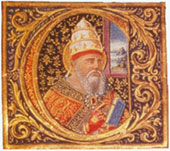|
 |
Brief chronology
•
He was born
at Rome about 540. Gregory’s father was Gordianus, a wealthy
patrician, probably of the famous gens Anicia. His
mother, Sylvia, is honoured as a saint and two of his aunts
have been canonized. As was customary for youth of his
social class, he undertook a political career, completing
studies in Legal Studies and Grammar. Subsequently he gave
up political life and became a monk, converting his palace
on the Caelian Hill into a monastery (St. Andrew) and
adopting the Benedictine Rule.
|
|
|
|
•
In 579 he was called by Pope
Pelagius II and ordained deacon and sent to Constantinople.
On his return the Pope made him his councilor.
•
In 590, after the death of Pope
Pelagius II, he was elected Pope, with great consent from
the people as well. He dedicated himself to his city – Rome
at the time suffered with plague and hunger, but even more
significant was his “political” work in stopping the
expansion of the Longobards and supporting Queen Theodolinda
against the Arian heresy in the East. He was instrumental in
the Christianization of the present England.
He was the author of many other reforms, including reforms
of the Roman liturgy and sacred song.
•
He died at Rome in 604.
|
|
The Works of St. Gregory the Great
* Commentary on Job. 35 books. “Encyclopedia” on every
aspect of the Christian life.
* The Rule for Pastors. A “manual” of Christian pedagogy,
acutely psychologically.
* Dialogues, 4 books. A collection of the lives and miracles
of Italian saints from the V and VI centuries. It includes
the first biography of St. Benedict.
* Sermons on the Gospels. 40 homilies to people in the first
years of his pontificate.
* Sermons on Ezekiel. 22 homilies given during the invasion
of the Longobards in Rome.
* Letters. Some 850 have survived from his Papal Register of
letters. This collection is the first complete collection of
letters by a Pope. It serves as an invaluable primary source
for these years.
Other minor works:
* Commentary on the Song of Songs
* Commentary on the First Book of the Kings
|
|
Origin
The Book of
the Pastoral Rule, commonly known in English as “Pastoral
Care”, is a treatise on the responsibilities of the clergy
written by Pope Gregory the Great around the year 590,
shortly after his papal inauguration. The text was addressed
to John, the bishop of Ravenna, as a response to a reprimand
on his part for having wanted to escape from the
responsibilities of the Pontificate. He seeks to give moral
justification for this flight which is the presupposition
and the background from which the construction of the Rule
takes its origin. Gregory seems to be saying that he feels
strongly the contrast between what we are called to be and
unfortunately what we are. Aware of what we are, the
tendency is to refuse what we pray we want to be, not so
much because it’s too hard, but because we don’t feel
worthy. This fear, - the consciousnesses of weakness,
inadequate instrument, deaf matter which resists form and
ideal, - is Gregory’s doubt and perplexity. But this very
fear is the strength, the ethical value, the aesthetic
moment from which the “Rule” has its origin, such a
Gregorian creature, for the Shepherd of Souls.
Content
The
holiness of Gregory the Pastor is identified with the Pastor
of the Rule. The Rule can be defined as the attempt to
construct the pastor of souls
Part
one addresses the question of "who" should
take on the pastoral rule in the Church. He points out the
difficulties and the burdens. Talks about the “requirements”,
the conditions that make a real Pastor and the other side of
the medal: that is, the defects and vices that must never be
present and must be avoided.
Part
Two is dedicated to the life of the Pastor. In it he
discusses the "lift" of the Pastor, and the moral
qualities he must have.
Part
Three addresses "How the ruler, while living well
(righteously), ought to teach and admonish those that are
put under him." There are 36 Admonitions which instruct
the pastor how to deal with people.
Part
Four of the Pastoral Rule is a very brief chapter on
the importance of self examination on the part of the
pastor. Here is found a long discourse on virtues including
humility.
|